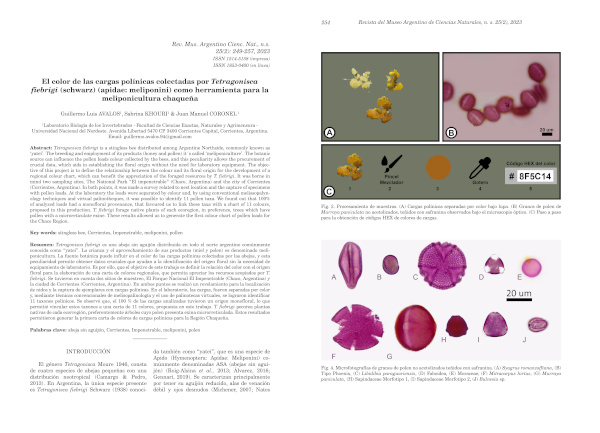El color de las cargas polínicas colectadas por Tetragonisca fiebrigi (schwarz) (apidae: meliponini) como herramienta para la meliponicultura chaqueña
Palabras clave:
Corrientes, Impenetrable, meliponini, polen, TetragoniscaResumen
Tetragonisca fiebrigi is a stingless bee distributed among Argentine Northside, commonly known as ‘yateí’. The breeding and employment of its products (honey and pollen) it´s called ‘meliponiculture’. The botanic source can influence the pollen loads colour collected by the bees, and this peculiarity allows the procurement of crucial data, which aids in establishing the floral origin without the need for laboratory equipment. The objective of this project is to define the relationship between the colour and its floral origin for the development of a regional colour chart, which can benefit the appreciation of the foraged resources by T. fiebrigi. It was borne in mind two sampling sites, The National Park “El impenetrable” (Chaco, Argentina) and the city of Corrientes (Corrientes, Argentina). In both points, it was made a survey related to nest location and the capture of specimens with pollen loads. At the laboratory the loads were separated by colour and, by using conventional melissopalynology techniques and virtual palinotheques, it was possible to identify 11 pollen taxa. We found out that 100% of analyzed loads had a monofloral provenance, that favoured us to link these taxa with a chart of 11 colours, proposed in this production. T. fiebrigi forage native plants of each ecoregion, in preference, trees which have pollen with a microreticulate exine. These results allowed us to generate the first colour chart of pollen loads for the Chaco Region.
Descargas

Descargas
Publicado
Número
Sección
Licencia
Los autores/as que publiquen en esta revista aceptan las siguientes condiciones:- Los autores/as conservan los derechos de autor y ceden a la revista el derecho de la primera publicación, con el trabajo registrado con la licencia de atribución de Creative Commons, que permite a terceros utilizar lo publicado siempre que mencionen la autoría del trabajo y a la primera publicación en esta revista.
- Se permite y recomienda a los autores/as a publicar su trabajo en Internet (por ejemplo en páginas institucionales o personales), ya que puede conducir a a una mayor y más rápida difusión del trabajo publicado.
